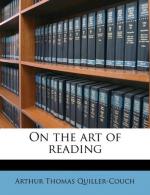Very good so far. It opens like the story of Nausicaa ["Odyssey,” Book vi, lines 81-86].
The lady wished the donkey to bathe its legs in the sea, to make it strong and clean. But the donkey did not like to go near the sea. So the lady bound a brown shawl over its eyes, and she bade the big girls lead it close to the waves. Suddenly a big wave rushed to the land. The girls started back to avoid the wave, and they let go the donkey’s rein.
The donkey was alarmed by the noise the girls made, and it went into the sea, not knowing where it was going because it was not able to see. The girls ran screaming to the lady, crying out, ‘The donkey is in the sea!’
There it was, going further and further into the sea, till the cart was hidden by the billows. The donkey sank lower and lower every moment, till no part of it was seen but the ears; for the brown shawl was over its nose and mouth. Now the children began to bawl and to bellow! But no one halloed so loud as the little boy of four. His name was Merty. He feared that the donkey was drowned....
Two fishermen were in a boat far away. They said ’We hear howls and shrieks on the shore. Perhaps a boy or girl is drowning. Let us go and save him: So they rowed hard, and they soon came to the poor donkey, and saw its ears peeping out of the sea. The donkey was just going to sink when they lifted it up by the jaws, and seized the bridle and dragged it along. The children on the shore shouted aloud for joy. The donkey with the cart came safe to land. The poor creature was weak and dripping wet. The fishermen unbound its eyes, and said to the lady, ’We cannot think how this thing came to be over its eyes.’ The lady said she wished she had not bound up its eyes, and she gave the shillings in her purse to the fishermen who had saved her donkey.
Now every child knows that a donkey may change into a Fairy Prince: that is a truth of imagination. But to be polite and say nothing of the lady, every child knows that so donkey would be ass enough to behave as in this narrative. And the good parents who, throughout the later 18th century and the 19th, inflicted this stuff upon children, were sinning against the light. Perrault’s Fairy Tales, and Madame D’Aulnoy’s were to their hand in translations; “Le Cabinet des Fees”, which includes these and M. Galland’s “Arabian Nights” and many another collection of delectable stories, extends on my shelves to 41 volumes (the last volume appeared during the fury of the French Revolution!). The brothers Grimm published the first volume of their immortal tales in 1812, the second in 1814. A capital selection from them, charmingly rendered, was edited by our Edgar Taylor in 1823; and drew from Sir Walter Scott a letter of which some sentences are worth our pondering.
He writes:




